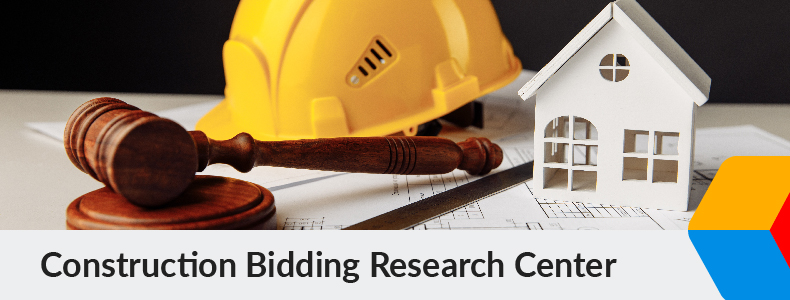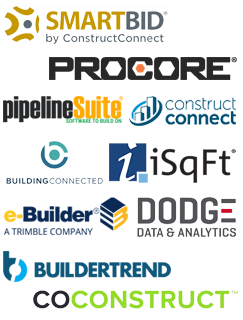Construction bidding is a process where contractors submit tenders to clients for managing construction projects.
From creating cost estimates to performing material takeoffs to generating proposals, it’s a time-consuming process. That’s why several companies invest in construction bidding solutions to streamline workflows.
If you want to know how construction bidding helps win profitable jobs, build meaningful relationships, make informed decisions, reduce risks and enhance collaboration, you’re in the right place.
Win better jobs
Construction bidding provides an opportunity to secure new projects and expand your business. Participating in the bidding process gives you access to diverse projects and clients.
The process consists of six stages:
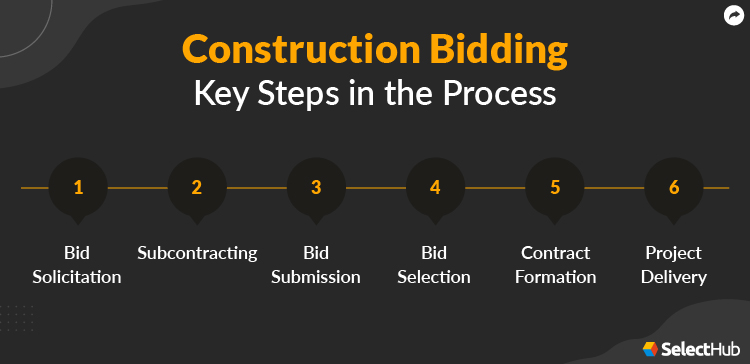
[addtoany]
Solicitation
The project owner or the client sends a construction request for proposal (RFP), an invitation to bid (ITB) or a construction request for quote (RFQ) to interested parties.
Government construction jobs are open to all qualifying contractors. Several public agencies use dedicated government portals like System for Award Management (SAM) to post bid opportunities to help you access project information, download bid documents and submit bids electronically.
Commercial and private project owners solicit various types of bidding in construction, including:
- Open Bidding: Clients invite contractors to submit bids openly to attract a wide range of interested contractors.
- Non-Competitive Bidding: Project owners send bids to a smaller group of contractors without a formal competitive process. This approach is used when project owners have existing relationships or prefer to work with specific contractors.
- Bid Management Platform: Contractors access bid information, submit bids electronically and communicate with the project owner through the platform.
Irrespective of the project type, bid packages consist of important documents to help you generate an accurate proposal. They include:
- Project specifications
- Job requirements
- Architectural and engineering drawings
- Contract type
- Project delivery methods
- Terms and conditions
Note: Request for quotation and request for qualifications have the same acronym (RFQ), but they’re two different things. Clients send requests for qualifications to prequalify contractors based on their past experiences and professional qualifications.
Subcontracting
Once you receive project specifications, you can start searching for subcontractors. Construction bidding applications help you access subcontractor databases to find the right sub for the job.
Bid Submission
After reviewing bid documents sent by the client and finalizing subs, you can start preparing your bid proposals. To submit an accurate bid, you need to estimate project costs correctly. It should include:
- Labor
- Materials
- Equipment
- Profit margin
- Overhead
You can use construction estimating applications to generate accurate estimates.
Sometimes you offer the lowest cost possible to win bids. But that won’t help you in the long run. It could hamper your financial goals. You need to devise a bidding strategy to improve your bid-hit ratio.
You might even have to submit a bid bond to show your seriousness and commitment to the project.
Bid Selection
Public project owners will always select the bid with the lowest price. On the contrary, commercial clients consider several factors like scheduling philosophy, project experience and safety record while evaluating bids.
To assess multiple bids in a standardized and systematic manner, project owners use the bid leveling technique. This helps minimize bias, subjectivity and ambiguity in the evaluation process, promoting transparency and accountability.
Contract Formulation
Here, the client drafts a legal framework and generates a contract. Remember to discuss the terms and conditions of the contract before signing it.
Project Delivery
Clients determine the project delivery method in the bid documents. It plays a significant role in shaping the bidding process and subsequent project execution.
For example, if the project delivery method is design-build, contractors with strong design capabilities and experience in managing both design and construction aspects will have a competitive advantage.
You need to understand the specified project delivery method as it influences your bidding strategy, contractual obligations and the overall project execution approach.
It’s good to have an idea about procurement methods (also known as tendering techniques). Some of the standard techniques are as follows:
- Best Value Source (BVS): The client awards the job to a contractor based on price and past performance. They also consider other factors like time management, qualifications and robustness. That’s why you need to maintain your reputation in the eyes of the owner.
- Negotiated: The project owner engages in direct negotiations with one or a select few contractors based on their qualifications, expertise and track record to establish the terms and conditions of a construction contract. They discuss pricing, project schedule and technical requirements.
- Sole Source or Direct Select: The client selects a single contractor who can fulfill all project requirements. It’s commonly known as the non-competitive procurement method. It’s beneficial for contractors.
- Low Bid: Government and public entities use this technique. They evaluate multiple competitive bids and award the project to the contractor with the lowest bid.
- Serial Tendering: A property owner seeks bids for a sequence of similar projects spanning a certain duration. This method alleviates the need to repeatedly solicit bids for similar projects, but it may also result in reduced competition among contractors.
Once you understand how your clients think, you can generate accurate bid proposals and win profitable jobs.
Build meaningful relationships
In the fast-paced world of construction, bidding isn’t just about winning contracts — it’s about forging meaningful relationships that stand the test of time.
Construction bidding can indeed help contractors build meaningful relationships in several ways:
- Seize Networking Opportunities: You can connect with a wide range of potential clients, including property owners, developers, architects and project managers.
- Showcase Competence: By submitting well-prepared bids that highlight their qualifications, experience and successful project deliveries, you can establish your reputation as a reliable and competent professional.
- Cultivate Trust: The bidding process involves face-to-face meetings and negotiations between contractors and potential clients. These interactions provide you with an opportunity to build trust and rapport with customers. By actively engaging in open communication and addressing client concerns, you can establish yourselves as trustworthy partners.
- Foster Collaboration: Clients may consider contractors who develop positive relationships with them, even in unsuccessful bidding attempts, for future projects or subcontracting opportunities.
- Secure Repeat Business: Successful construction bidding and project delivery can lead to repeat business from satisfied clients. By consistently meeting or exceeding client expectations, you can foster long-term relationships, securing additional projects without having to go through the bidding process again.
From the initial handshake to the final negotiations, bidding opens doors to a world of networking, trust-building and collaboration.
Make informed decisions
You can’t bid on each and every project. You should make bidding decisions based on your expertise. If you chase after the wrong project, your efforts and resources will go in vain. You need to make decisions that can drive your business towards success.
Below, we’ve highlighted some factors you can consider to speed up decision-making processes.
- Evaluate project costs and calculate profit margins
- Review project backlogs before you bid on a new job
- Access historical records to make bid comparisons
- Identify potential risks like incomplete documents, safety concerns and accelerated timelines
- Analyze if the project fits into your long-term goals
You should create a grading matrix to make bid/no-bid decisions. A data-driven approach can help you decide quickly.
Bid strategy reports assist you in evaluating your bid performance. You can generate these reports using construction bidding apps to monitor metrics like bid statuses, conversion delays and average targets. Bid leveling functionality enables you to compare multiple bids side by side.
Mitigate Risks
During the bidding process, you have the opportunity to evaluate the project in detail, including its scope, specifications and potential risks.
By conducting a comprehensive assessment, you can identify and understand the potential risks associated with the project, such as challenging site conditions, tight timelines or complex technical requirements. This early awareness allows you to develop appropriate risk mitigation strategies.
You can incorporate contingencies into your cost estimates to reduce financial risks and ensure you have resources available to handle unexpected challenges.
Boost collaboration
Construction bidding sets the stage for a symphony of teamwork where contractors, subcontractors and industry experts harmonize their skills and expertise.
It plays a significant role in boosting collaboration among contractors and various stakeholders in the following ways:
- Foster a Shared Project Vision: During the bidding process, you have the opportunity to engage with clients, architects and project managers to discuss project requirements and objectives. By aligning their understanding and expectations from the early stages, you can foster a collaborative mindset and set the foundation for effective teamwork throughout the project life cycle.
- Nurture Team Building: Construction bidding often requires you to form teams consisting of subcontractors, suppliers and other specialists. This enables different entities to come together to create a comprehensive bid.
- Encourage Subcontractor Collaboration: You need to collaborate with subs while bidding to gather relevant information, obtain accurate cost estimates and develop comprehensive project proposals. Effective collaboration between you and subcontractors leads to improved project outcomes and strengthens professional relationships.
- Promote Problem-Solving and Innovation: You need to propose innovative solutions and value-added suggestions to win bids on construction projects. This requires collaborative brainstorming and problem-solving sessions where you can use your expertise and experience to develop unique approaches.
Producing proposals isn’t a one-person job. You require estimators, architects, quantity surveyors and other important construction professionals to create a competitive bid. Each team member is dependent on the other to complete the job. And managing multiple teams is tedious.
Construction bidding applications help you automate tasks and save time. They assist you in monitoring workers’ activities and submitting tenders within assigned deadlines.
Some features that could help promote harmony and increase productivity are as follows:
The right solution can help you communicate effectively and manage projects from start to finish.
FAQs
How can I find bidding opportunities?
Clients may post their project files on construction bidding portals (more common in government projects). You can visit these websites and submit your bid electronically.
Some of the common portals are as follows:
Read our article — How To Bid on Construction Jobs — to know more.
What are the common project delivery methods?
Owners select a project delivery method to create an execution plan for a construction project. Some widely used methods include:
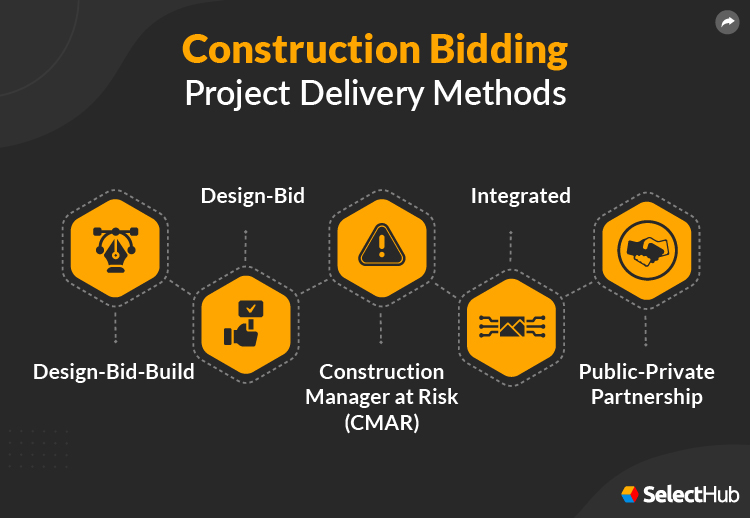
[addtoany]
- Design-Bid-Build: It consists of three phases — design, bid and build. In the design phase, the project owner works with an architect to develop drawings and other exhibits to help contractors understand project requirements. Then the bidding process begins where the manager evaluates bids and awards the job to the contractor with the most competitive bid. At the last stage, the contractor starts working on the project.
- Design-Build: Here, the client hires a contractor who can fulfill the roles of a designer as well as a builder. This can cut the lengthy timeline involved with the design-bid-build method.
- Construction Manager at Risk (CMAR): The client hires a construction manager to oversee construction processes. From inception to completion, the manager handles all aspects of the project. When the manager is halfway through the design stage, they need to submit a guaranteed maximum price. It ensures the project owner that the job costs won’t exceed the guaranteed maximum price.
- Integrated Project Delivery: The project owner selects team members responsible for the project and connects them to a single contract. Everyone shares project risks equally. This method promotes collaboration and increases efficiency.
- Public-Private Partnership: The public sector entity typically provides the necessary infrastructure or public service requirements, while the private sector entity contributes the expertise, financing and operational capabilities. It’s a contractual agreement where both parties share responsibilities, risks and rewards in delivering and operating a public infrastructure project.
What are the different contract types?
Mainly the owner decides on the contract format. Keeping yourself updated with different contract types can help you generate error-free contracts. We’ve outlined some of the most used contract types below.
Guaranteed Maximum Price
In a guaranteed maximum price contract, the contractor agrees to complete a project for a set maximum price, which is typically based on a detailed scope of work and project specifications.
You need to provide a detailed breakdown of costs, including labor, materials, subcontractor fees and overhead expenses. You and the client will share any savings or cost reductions according to a predetermined agreement.
Cost-Plus
In a cost plus contract, the contractor actively incurs the expenses associated with the project and submits invoices to the client for reimbursement. The invoices include the actual costs incurred, such as materials, labor, equipment and subcontractor fees. The client then pays the contractor the full amount of these costs.
Additionally, the contract includes an agreed-upon fee or percentage that the contractor adds to the reimbursed costs. This fee is meant to cover the contractor’s services, management and overhead expenses, as well as provide a profit margin.
To ensure a successful cost plus contract, it’s important for the client and contractor to establish clear communication and a robust system for tracking and documenting expenses.
Fixed-Price
The contractor actively agrees to undertake the entire project and deliver all the required services, materials and deliverables for a predetermined, fixed price as agreed upon by the client. The client and contractor determine this fixed price through negotiations and discussions prior to project commencement.
It provides clarity and simplicity in terms of cost management for the client. The project owner knows the total cost of the job upfront and can make informed decisions based on their budget constraints. However, it also places a higher level of risk on the contractor, as any cost overruns or unforeseen expenses will impact their profitability.
Time and Material
In a time and material contract, the contractor actively tracks and invoices the client based on the actual hours worked by the contractor’s team and the cost of materials used throughout the project.
While this contract provides transparency in terms of cost, it also carries the risk of cost uncertainty for the client. The contractor’s efficiency and productivity directly impact the total cost and any delays or inefficiencies could result in increased expenses.
Unit Price
In a unit price contract, the client agrees to pay the contractor based on pre-established unit rates for specific quantities of work or materials. It breaks down the project into measurable units, such as cubic meters of concrete poured, linear feet of pipe installed or tons of steel used.
Under this contract, the contractor actively calculates the total cost by multiplying the agreed-upon unit rates by the actual quantities of work completed or materials supplied.
The contractor and project owner determine unit rates through negotiations.
We advise you to study these contract types thoroughly to avoid drafting mistakes.
What’s the difference between an estimate and a bid?
Most project managers use the terms bidding and estimating synonymously. But in reality, they’re quite the opposite.
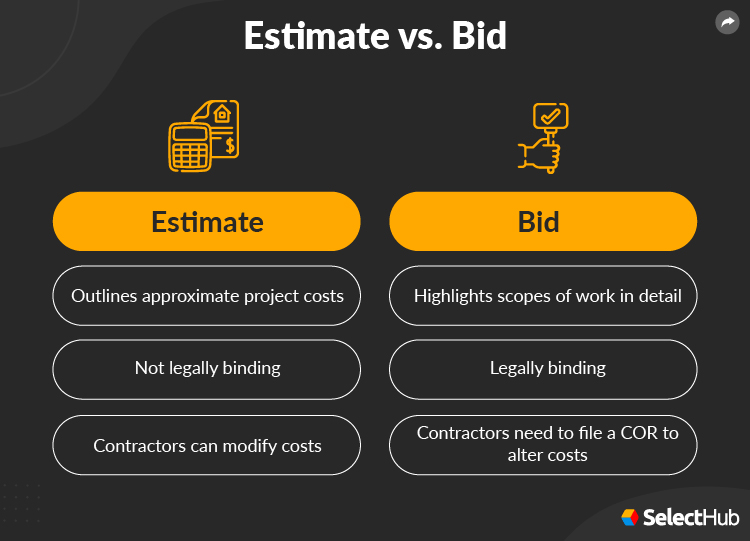
[addtoany]
An estimate is an approximate cost you calculate to get an idea about your project expenses. It mostly involves guesswork due to a lack of data availability. It consists of scopes of work, timelines, exclusions and other important details.
An estimate is just a ballpark number that’s not legally binding. You can change the costs once you get the actual values.
A bid highlights scopes of work and other project information in detail. Once the client awards you the bid, you’ll have to honor the commitments made in it.
If you take longer than usual to complete the project, you must file a change order request (COR) to alter project specifications, timelines or costs.
What are the key decisions owners make before issuing an RFP?
You need to step into the client’s shoes to understand their processes. Once you know, you can leverage it to win jobs. The three major structural decisions clients make that can impact your bidding processes are as follows:
- Project delivery method
- Procurement technique
- Contract type
What are the common bidding issues?
Bidders encounter multiple challenges. And if you’re unaware of such problems, you won’t be able to win jobs. Some of the common challenges are listed below.
- Finding bid packages
- Drafting a compelling bid proposal
- Bidding on wrong jobs
- Failing to meet RFP requirements
Construction bidding solutions can help you overcome such problems. Some of the features that bidding platforms offer are:
- Bid evaluation
- Customizable proposal templates
- Subcontractor databases
- Pre-qualification tools
What’s the best way to overcome bidding challenges?
Bidding for construction projects isn’t an easy task. It comes with a lot of challenges. We’ve listed some things you can do to solve bidding challenges below.
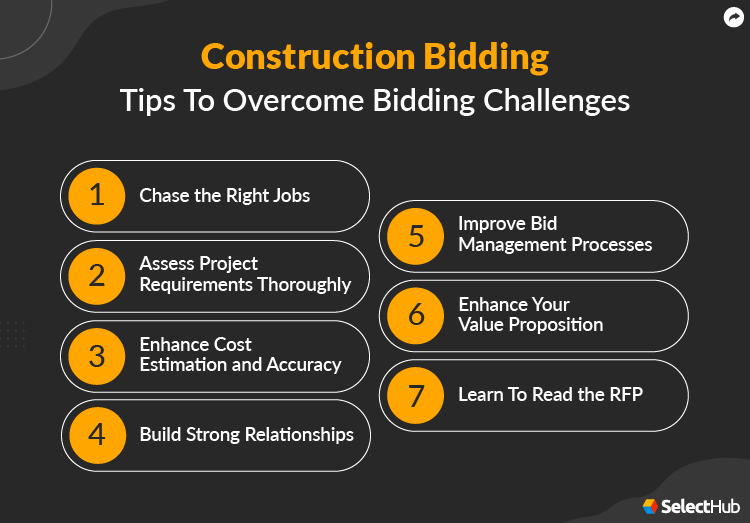
[addtoany]
Chase the Right Jobs
When it comes to overcoming the challenges of bidding on construction jobs, it’s crucial for you as a contractor to develop a lead evaluation checklist. This checklist serves as a valuable tool to help you make informed decisions before submitting a bid.
There are five key areas you should evaluate for every potential job: the client, the designer, the plans, specifications, and other bidders.
The client evaluation checklist should include:
- Prior building experience
- Budget
- Schedule
- Priorities
- Suppliers
The designer evaluation checklist should include:
- Design talent
- Technical competence
- Reputation with other contractors
- Responsiveness
The plans evaluation checklist should include:
- Waterproofing details
- Electrical plans
- Site grade
- Finish schedules
The specifications evaluation checklist should include:
- Scope of work
- Payment schedule
- Compliance and permits
- Alternative price requirements
- Change order process
The competition checklist should include:
- Experience
- Pricing strategy
- Reputation
- Differentiation
By thoroughly evaluating these aspects, you can avoid bidding on projects that may be too large, exceed your capabilities or carry unnecessary risks.
It’s important to know your limits and be selective, focusing on projects that challenge and expand your skills while remaining achievable.
Assess Project Requirements Thoroughly
Take the time to carefully review and understand the project specifications, scope and any unique requirements. Analyze the client’s needs, project goals and expectations. Conduct site visits if necessary to gather accurate information.
This thorough assessment enables you to develop a precise understanding of the project, allowing you to create a more competitive and accurate bid.
Enhance Cost Estimation and Accuracy
Invest in improving your cost estimation processes. Use historical data from previous projects to identify trends and patterns. Conduct detailed analysis of material costs, labor requirements, equipment needs and any other project expenses.
You can use estimating software to streamline estimating processes and reduce errors.
Regularly update and refine your cost database to ensure accuracy.
Build Strong Relationships
Establish strong relationships with reliable suppliers and subcontractors in the industry. Cultivate partnerships based on trust, quality and competitive pricing.
By having a network of trusted partners, you can obtain competitive prices for materials and services, ensuring that your bids are cost-effective.
Improve Bid Management Processes
Develop efficient bid management systems and processes. This includes organizing bid documents, creating a centralized database for relevant information and using bid management software if available.
Implement clear workflows and timelines to track bid opportunities, deadlines and submission requirements.
Enhance Your Value Proposition
Highlight your unique selling points, such as specialized expertise, successful track record, innovative solutions or cost-saving strategies. Clearly communicate how your experience and capabilities align with the project requirements and how they provide added value to the client.
Learn To Read the RFP
Delving into an RFP in detail provides crucial information on project timelines, deliverables and milestones. You can identify important dates such as the bidding deadline and project completion date, which enables you to plan your resources and schedules effectively.
Moreover, an RFP often outlines the evaluation criteria the client will use to assess and select the winning bid. By thoroughly understanding these criteria, you can tailor your proposal to emphasize the aspects that matter most to the client. This strategic approach sets you apart from competitors and increases your chances of securing the project.
How do I select a construction bidding system?
Embarking on a software selection quest is arduous. When you surf the internet, hundreds of bidding products pop up. And you might get stuck in an endless loop of confusion. We’re here to help you make your software selection journey a breeze.
It’s of paramount importance to determine your company’s needs. You can conduct surveys or brainstorming sessions to receive multiple opinions. You can also create a construction bidding requirements checklist to make sound decisions.
You should decide on your preferred deployment type, determine your organization size and go through your budget plans before finalizing a product.
After you understand your requirements, you should start comparing vendors based on them. You can use our comparison matrix to compare multiple providers. It also enables you to generate scorecards to help you choose a product that best fits your needs.
Don’t forget to check our construction bidding buyer’s guide to kickstart your product selection hunt.
Are you still wondering which vendor could bring value to your business? We’d love to solve your troubles. You can reach out to our team for individualized recommendations through email at support@selecthub.com or by phone at 855-850-3850.
